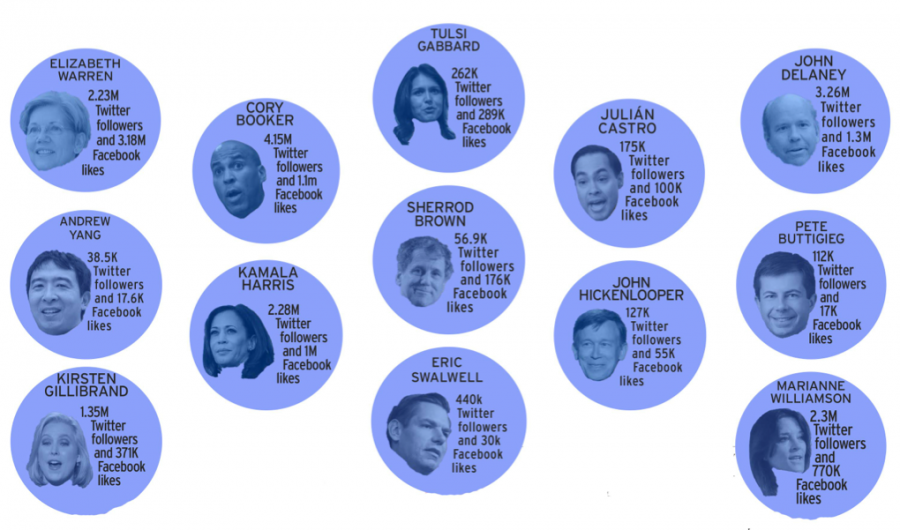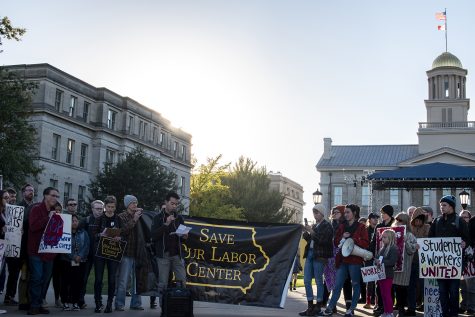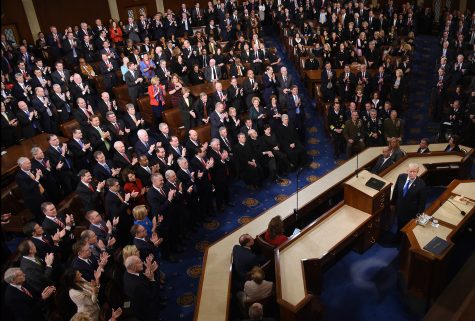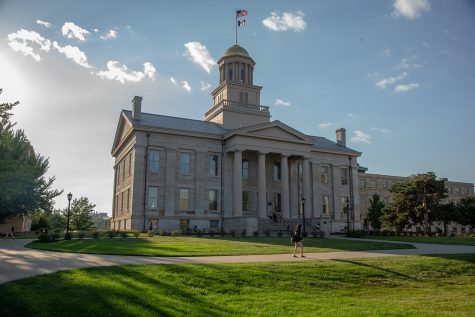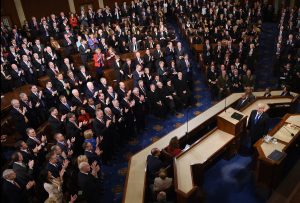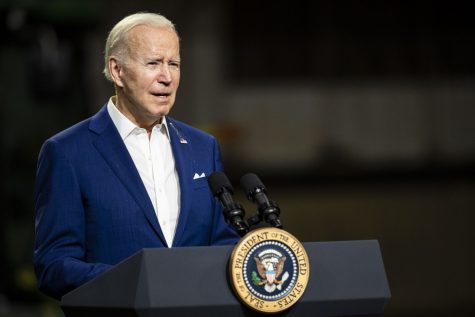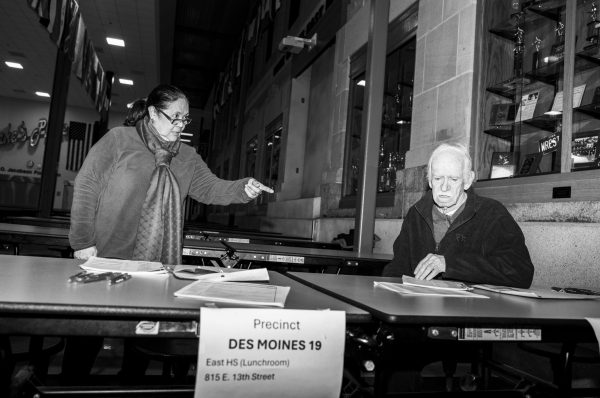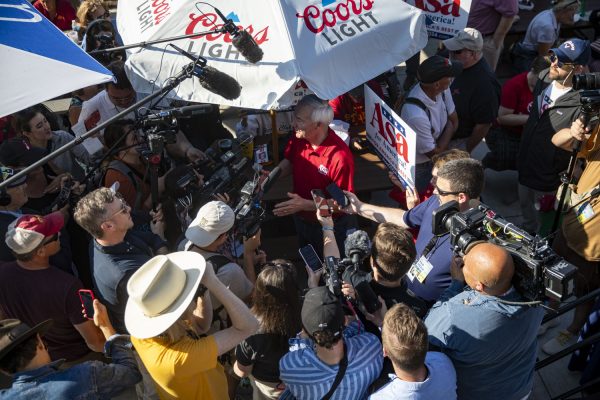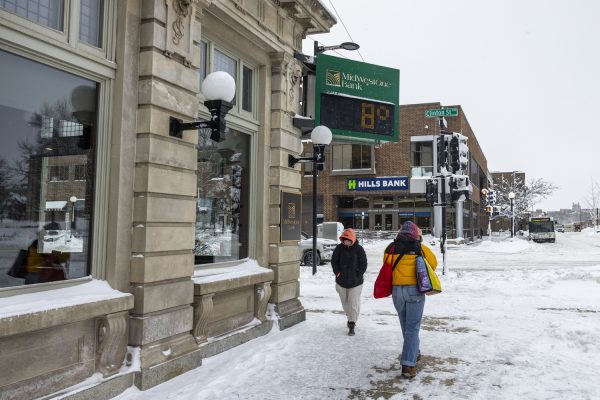As 2020 candidates flood Iowa, Democrats say social media is key to standing out
February weekends will be filled with candidates and potential candidates visiting the Hawkeye State and using social-media organizing tools to get out their messages.
February 5, 2019
As 2020 presidential-campaign announcements come one after another, and no clear front-runner for the Democratic nomination has yet emerged, candidates strategize how to best stand out amid nearly a dozen contenders.
Targeted social-media campaigns will be critical, Democratic activists say. Social-media use and online platforms have rapidly changed political campaigning over the last 20 years, and in 2020, interactivity online isn’t expected to slow.
In January 2016, nearly 45 percent of Americans surveyed by Pew Research Center said they learned about the previous week’s presidential election news from social media.
Reaching people in an online community may be even more important for contenders looking to win a “ticket” out of the Iowa caucuses in 2020 as the state Democratic Party looks to implement new rules handed down by the national party to provide an absentee option.
Normally, caucus-goers have to be at their designated precinct in person, but for 2020, Iowa caucus-goers may have the option to phone in or submit their preference online, Iowa Democratic Party Executive Director Kevin Geiken said. However, nothing is set in stone, he said, because state Democratic officials won’t release a delegate-selection plan until later this month.
Former campaigners and Iowa Democratic Party leaders told The Daily Iowan that success online is essential to success in the caucuses, but only if it’s intertwined with old-school, face-to-face interaction.
As these candidates are building a national conversation, these candidates aren’t just talking to Iowans. They’re talking personally to Iowans and through us to the whole rest of the country, and really, the whole world is watching.
— Sue Dvorsky, former Iowa Democratic Party chairwoman
“As these candidates are building a national conversation, these candidates aren’t just talking to Iowans,” former Iowa Democratic Party Chairwoman Sue Dvorsky said. “They’re talking personally to Iowans and through us to the whole rest of the country, and really, the whole world is watching.”
That whole rest of the country includes California, a state whose presidential primary has moved up to March 3. With early voting, Californians can begin to cast their votes the same day as the Feb. 3 Iowa caucuses.
California’s early primary schedule will make social-media messages out of Iowa all the more critical.
RELATED: Elizabeth Warren set to make stop in Iowa City Feb. 10
Sen. Elizabeth Warren, D-Mass., announced her exploratory committee on Twitter. Democratic New Jersey Sen. Cory Booker’s video tweet announcing his campaign was viewed more than 3 million times.
One of Booker’s first campaign emails implored people to follow him on top social-media platforms.
“So much of the story of this campaign will take place in your newsfeeds (seriously, Cory pulled out his phone to first announce this campaign). So if you’re not following him on Instagram, Twitter, or Facebook, now’s the time,” the email stated.
Olivia Habinck, the president of the organization College and Young Democrats of Iowa, said a strong following on social media will be critical for candidates to appeal to young first-time caucus-goers in 2020.
“A lot of us use social media, and that’s how we get our news, and that’s how we get our information,” she said.
A 2018 Pew Research review of social-media habits in adults showed that 88 percent of adults ages 18-29 used at least one social-media platform.
Habinck, a sophomore at Des Moines Area Community College, said she first got involved in politics because of opportunities to volunteer in 2016 that were pushed online.
Instant communication, however, may be a double-edged sword, Dvorsky said. Caucus-goers have access to real-time information as they decide which candidate to support.
During the 2008 caucuses, Dvorsky captained a Coralville precinct for Barack Obama. Polls leading into the Iowa caucuses measured the five most likely to be viable candidates competing for at least 15 percent of Iowa caucus-goers in each precinct, which would qualify them for delegates to represent them at the following conventions.
Then, social media was in its infancy, she said. Caucus-goers in gyms, city halls, and other venues across Iowa didn’t have access to the internet for instant updates on how candidates were faring in other precincts.
RELATED: Cory Booker set to visit Iowa City Feb. 8 after announcing 2020 presidential bid
“In the caucus process, there’s a lot of negotiating,” she said, describing how in 2008, precinct captains for certain candidates were trying to woo caucus-goers whose candidate didn’t garner the required 15 percent threshold.
Her youngest daughter ran into the precinct space at the Coralville Central Elementary School, crammed with 300-plus people, and promptly yelled into the room that Obama was winning across the state.
“I essentially clapped my hand over her mouth,” Dvorsky said. “Because at the time, as recently as 2008, each caucus was not in any kind of communication outside the room,” Dvorsky said.
But by 2016, that atmosphere of letting the caucus-goers deliberate without outside influences had changed Dvorsky said.
“By last time, everyone’s got a phone in their hand,” Dvorsky said. “So in the city halls, and in the gyms and in the caucus sites all over the state — the whole country is getting real-time feedback of what’s happening in the room. It utterly changed the nature of the caucuses.”
Looking ahead to 2020, there are not as many new social-media platforms for campaigns to explore, Habinck said, but tools on existing sites are evolving.
For example, personal Instagram and Facebook live stories are becoming more prevalent. Former Texas Rep. Beto O’Rourke, who was narrowly defeated in a 2018 Senate race against incumbent Ted Cruz, gave followers a close look at his dentist visit in an Instagram live video Jan. 10.
Instagram has been the platform with the highest growth. Approximately 35 percent of adults now report using Instagram, according to a 2018 Pew Research study.
Several congressional candidates in other states who became well-known in the 2018 midterm elections produced low-cost personal narrative-style videos that went viral on Twitter, allowing millions of people to see their messages.
For example, first-time candidate Jahana Hayes, now a Democratic representative from Connecticut, produced a video for $20,000 that brought in nearly $300,000 in donations.
RELATED: Author and 2020 candidate Marianne Williamson makes campaign stop at Prairie Lights
Meeting Iowans face-to-face
Jeremy Dumkrieger, the chair of Woodbury County Democrats, will tell you that Democrats in northwestern Iowa, in the 4th Congressional District where Republicans have an active voter-registration advantage of 20,000, did well when they visited counties numerous times on the campaign trail.
“People win because they show up,” he said. “Iowans know how to hunker down and take it seriously. It’s not a dog and pony show. It’s the real deal here.”
Democrat J.D. Scholten, a narrowly defeated 2018 candidate for Congress in Iowa’s 4th District, claimed in an op-ed that Republican Rep. Steve King’s narrowest win in years was because of Scholten’s relentless traveling around the district in an RV to meet voters, while King kept a relatively low profile.
Andrew Turner, state Auditor Rob Sand’s campaign manager, the only first-time Democratic statewide office winner in 2018, published an opinion piece in Iowa Starting Line that detailed a few reasons he believed Sand won, including that he worked his way through all 99 counties.
Conducting the caucuses with new tech
In 2016, the Iowa caucuses implemented an app so that caucus chairs could report results almost immediately.
“The urgency or timing of getting caucus results has changed,” Geiken said. “We are in a world in which people want info five minutes before it happens.”
This year, the Iowa Democratic Party is considering a process that Geiken said was once unthinkable — absentee caucusing, also known as “telecaucusing.” If implemented, Democrats may have a chance to phone in or submit their preference for a candidate online if they can’t make it to the caucuses. In the past, it was available to military members.
However, the state party has yet to declare that to be the new policy. A delegate-selection plan will be decided and a comment period on the new policies is slated to be issued this month.
As the nation and political pundits turn their attention to Iowa, Dvorsky warns, no one really knows what’s going to happen.
“Anyone who tells you they think they know what’s going to happen in February 2020,” she said, “is totally blowing smoke up your skirt.”



